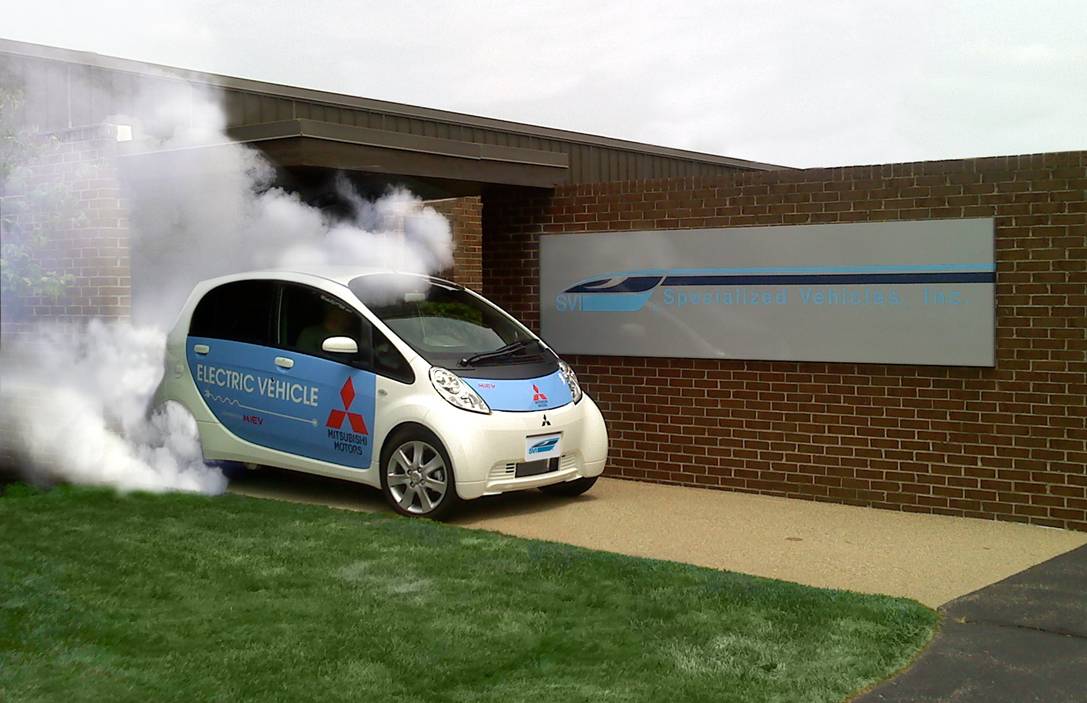Blog: A Car Guy Lives With The Mitsubishi i-MiEV

"Rex Roy spends a week with the Mitsubishi i-MiEV." To those who know me, this would be an experiment on the order of Wife Swap. Producers of that wacky and twisted program intentionally find completely incompatible families and have the husbands swap spouses. Tension, irony, and humor ensue. Sometimes individuals learn acceptance, open-mindedness, and ways toward better living. Other times, disaster on the order of one-in-the-head, two-in-the-chest is narrowly averted.
So how would I fare with this darling of the green community? The cards weren’t stacked in my favor. My list of worries more serious than Global Warming includes an imminent attack of killer bees (I live in Michigan) and a ride-by shooting propagated by renegade Amish teens.
I intellectually don’t believe these vehicles to be immediately necessary, nor does my selfish side think they provide much driving satisfaction. Because I’d driven plenty of electric golf carts over the years, my greatest initial curiosity was how many anti-i-MiEV one-liners I could develop over a week.
This would be fun.
Now before WR’s environmental elite sick Joy Behar on me, I do exhibit a small degree of mental complexity demonstrating some proclivity of green behavior: I’ve owned the same battery-powered Black & Decker electric lawn mower for 13 years.
The i-MiEV Arrives
As WR.com readers know, the name stands for Mitsubishi Innovative Electric Vehicle (MiEV) that’s based on the Mitsu’s "i" minicar. Mitsubishi is bringing the i-MiEV State Side late in 2011, so its PR department brought a small fleet of right-hand drive, Japanese Domestic Market (JDM) vehicles over here to gauge how American’s might respond.
Irony of irony, I was selected to be a driving, note-taking guinea pig for a week.
My journalistic goal was to treat the i-MiEV like any of the other 40 or so test vehicles I evaluate annually…but with more focus on one-liners. It would be judged on whether it is a good car—not whether it is "good for an electric," or "good for a green car." I was not reviewing a gussied up golf cart, but a vehicle type that some are calling the future of motoring.
Furthermore, Mitsubishi says the i-MiEV will be marketed as a real car, just like the soon-to-be-available Nissan Leaf and Chevrolet Volt. The world must know whether these vehicles are real cars as opposed to compromised, sub-par substitutes.
Sizing the i-MiEV up in the driveway, it looks like it could be the future of automobiles—at least for the practical future. The style of the cold-capsule shaped body grows on you after the shock subsides. Inside, the tall exterior profile provides huge headroom and ample space for four adults. Grocery bags fit in the cargo area, accessible via the rear hatch.
Around front, there’s no hood, but that’s not really a surprise because there is also no engine. One properly calls it a "motor" because it’s electric, and it’s under where you’d put your groceries at the rear of the vehicle. In keeping with the fact that there’s no engine, there is also no fuel tank. Instead, under-floor modules hold 88 lithium-ion cells that release up 330 volts to the motor.
A traditional-looking fuel door hides the charging port. Because the i-MiEV is based on a car with an internal combustion engine, the design team took the liberty of putting the charge port in the traditional "fill’er up" location. It feels natural that the plug goes in there. The i-MiEV comes with a custom 110/220-volt extension cord that is stored in a heavy-duty, logoed nylon grocery bag. (WR readers who are also boaters will recognize the cord as a cousin to shore power cables for cruisers, except it’s black not yellow.) It didn’t take up much room in the trunk, so it remained there on the off chance I’d need to "refuel" on the road. Recharging the batteries takes about 14 hours on 110-volts and about half that with household 220-volt service.
Getting behind the wheel of the i-MiEV is more comfortable than climbing in most cars. The car’s high roof and near-perfect seat height let you slide in with perfect ease. Because the car was JDM—and therefore right-hand drive—I did open the passenger door a few times out of habit.
Once behind the wheel, everything was familiar, except for the turn signals being on the right side of the steering column and the wiper controls being on the left. More than once I sprayed the windshield instead of properly indicating my intention to turn.
It only took a few miles to roll by before I realized how refined the i-MiEV was. This is not a fancy golf cart. It is most certainly a real car with real performance than can function in real driving environments.
Not every driving environment, but I’ll get to that.
My first outing was a cross-town drive totaling around 50 miles. In a conventional car, as long as you had a couple gallons in the tank, you wouldn’t think twice. However, in the i-MiEV, the range anxiety began as soon as I turned on the key and saw that even on a full charge, my estimated driving range before I needed to plug back in was only 100 kilometer (about 62 miles).
Based on my knowledge of electric vehicles, this round trip with multiple stops could end up being tricky. The day’s 85-degree temperatures and nearly equal humidity didn’t do the i-MiEV any favors. Running the AC on an electric vehicle dramatically increases power consumption, reducing driving range. Knowing that electric vehicles do better in city driving with modest speeds and frequent stops (allowing for battery charging through regenerative braking), I took surface streets on the outbound leg instead of the Interstate.
What a piece of cake. On the divided road, the i-MiEV easily kept pace with traffic while the A/C blew ice cold. The electric drive system was so eerily quiet that I had to keep checking my velocity to make sure I wasn’t speeding. The ride was civilized and comfortable. In a word, the cross-town drive proved effortless.
What was even better than the i-MiEV’s performance was people’s reaction to it. It cleared an automotive hobby shop. The guys were standing around with their hands in the pockets, just as if they were looking at a vintage Hemi ‘Cuda. Questions flew.
The same thing happened at an ice cream shop.
My third stop was a nationally recognized automotive skunk works, Specialized Vehicles, Inc. located in Troy, Michigan. SVI has built some of the fastest vehicles in the world. Like a typical car guy, owner Mike Koran wondered how fast his shop could make the Mitsu go. Just like motorheads looking at a Corvette, we talked about adding more batteries or super capacitors or front-wheel hub motors.
In its current state, the i-MiEV isn’t a rocket. Tests indicate that 0-60 mph comes up in a glacial 13.5 seconds, but curiously, it feels faster than that. That sensation of feeling as if I was going to get run over by a semi? I never felt that.
Regarding the joy of high-g corning—I never felt that either. Sporty handling is not something the i-MiEV delivers. Understeer is its natural condition, a condition that comes on quickly after the tall body takes a steady list in any particular corner.
If you stay in the throttle long enough, the i-MiEV will top more than 70 mph, something I discovered as I drove back home on the Interstate. The steering gets touchy at higher speeds. The soft dampers allow for some wishy-washiness that would quickly induce motion sickness from passengers.
Running 65+ mph quickly depleted the i-MiEV’s batteries. I nervously watched the digital "fuel" gauge drop. Had there been a real danger of not making it home, I could have taken an off-ramp, driven on surface streets, and turned off the A/C. As it was, I hit the driveway with several kilometers showing on the range gauge and dry armpits.
Knowing we were going out for dinner later that same day, I had to get some electrons back into the i-MiEV’s batteries. Fortunately my garage has a 110-volt outlet, so plugging in the Mitsubishi was convenient. Mostly.
The car pulls 15 amps, so when I went to juice it up, everything in the garage went black. The combination of the i-MiEV and my charging lawn mower tripped the circuit’s 15-amp breaker. Thankfully, nothing essential shared the circuit. I unplugged the mower and re-set the breaker.
That evening, after attracting more attention at dinner and at a different ice cream shop, I parked the i-MiEV in the driveway next to my daughter’s Ford Focus. The charging umbilical cord stretched into the garage. This scene struck me as a transitory manifestation of the future of driving—homes that have an EV for shorter trips and one traditional car capable of longer trips at higher speeds.
Unfortunately, given the i-MiEV’s expected price of around $30,000, it’s not a truly economical choice even though I had driven nearly 80 miles and only consumed pennies worth of electricity.
To compare, the slightly larger $13,000 Nissan Versa gets excellent fuel economy and is not encumbered by any range restrictions or charging delays. Plus, the Versa likes being hustled and gives its drivers some joy in motoring. For these and other reasons, the i-MiEV and others of its ilk do not yet represent the end-all-be-all answer to a fossil-fuel-free transportation future. Much more progress needs to be made to improve performance and reduce cost.
Sure, it’s a step, but that’s a lame position to offer vapid encouragement.
Value aside, as a short-distance transportation appliance, the i-MiEV works well. It does not, however, offer anything to the enthusiast beyond the grins of being involved in an elaborate social and engineering experiment.
Even though a Smart driver waved at me, the i-MiEV did not turn me into a greenie. That would have been a miracle. But the little Mitsu, to my surprise, did not invite vitriol—or the expected one-liners—upon itself. In contrast, the i-MiEV proved itself to be a completely competent vehicle, not an electrified Yugo or some kind of impractical science fair experiment.
If it were, I would have told you so, and it would have been my pleasure.


















